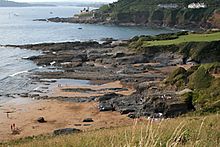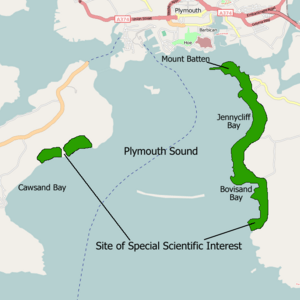Plymouth Sound, Shores and Cliffs facts for kids
| Site of Special Scientific Interest | |
 |
|
| Area of Search | Devon Cornwall |
|---|---|
| Coordinates | 50°20′46″N 4°07′19″W / 50.3461°N 4.12208°W |
| Interest | Geological |
| Area | 44.3 hectares (0.443 km2; 0.171 sq mi) |
| Notification | 1997 |
Plymouth Sound, Shores and Cliffs is a really special place in England. It's called a Site of Special Scientific Interest (SSSI) because of its amazing rocks and fossils. This area is found around Plymouth Sound, which is a big body of water where the River Plym and Tamar rivers meet the sea.
The site stretches across parts of Devon and Cornwall, including the city of Plymouth. What makes it so special? Its cliffs hold clues to Earth's past, showing rocks from the Middle to Early Devonian period. This was hundreds of millions of years ago! You can find fossils of ancient plants and sea creatures here.
Contents
Discovering Ancient Rocks

The rocks you see along these coastal cliffs and in the areas uncovered at low tide are from the Lower to early Middle Devonian period. These rocks were formed a very long time ago, between 417 and 354 million years ago.
Fossils: Clues to the Past
When you look closely, you can find many different kinds of fossils in these rocks. These fossils are like snapshots of ancient life. You might spot:
- Corals: Like the ones in today's oceans, but from millions of years ago.
- Brachiopods: Small sea creatures with two shells.
- Bryozoa: Tiny animals that live in colonies, often looking like lace.
- Gastropods: Ancient snails.
- Rare orthoconic nautiloids: These were ancient squid-like creatures with straight shells.
- Ostracods: Tiny crustaceans, like small shrimp.
- Trilobites: Famous ancient sea bugs that are now extinct.
- Crinoids: Sometimes called "sea lilies," they look like plants but are animals.
- Ancient fish: Including ostracoderm and acanthodian fish, which were some of the earliest fish with jaws.
How the Cliffs Were Formed
The cliffs at places like Jennycliff Bay show amazing rock formations. You can see how the layers of rock have been bent and folded. Some folds are very sharp, like zigzags, which geologists call "chevron" forms.
These folds happened because of huge pressures on the rocks. This pressure also created "cleavage," which are tiny cracks or splits in the rock. It's like the rock was squashed so hard it started to split into thin sheets. This is very clear in the slate and siltstone rocks.
By studying these rock layers, scientists can figure out how the land moved and changed over millions of years. They can tell that these rocks were once part of a huge bend in the Earth's crust called the Dartmouth Antiform. This big bend stretches all the way from Newquay to Dartmouth.
Evidence of Earth's Movements
The way the rocks are folded and cracked tells us about a time when Earth's tectonic plates collided. This happened between 330 and 300 million years ago. Imagine two giant pieces of Earth's crust pushing against each other! This immense pressure caused the rocks to bend and fold.
At Bovisand Bay, you can see evidence of three different times when the rocks were folded. This shows that the area experienced pressure and movement multiple times. The very southern part of the area has red and green slates mixed with sandstones. These rocks were laid down in ancient rivers and lakes.
Rocks on the Cornwall Side
On the western side of Plymouth Sound, in Cornwall, the rocks are even harder. Here, you'll find Staddon Grit, which forms a strong headland at Staddon Point. There are also layers of sandstone that were once ancient marine sandbars.
Along most of the coast, you can see dramatic faults (where rocks have broken and slid past each other) and more amazing folds. In some spots, the rocks still show that clear zigzag or chevron pattern, which is a fantastic sight for anyone interested in geology!

